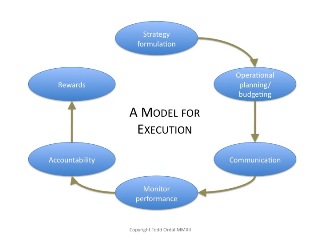

Witness to an execution
Todd Ordal //October 24, 2012//
Many management gurus will say, “It’s all about the execution.” They’re wrong. If you execute the wrong strategy brilliantly, you just fail faster. It’s about brilliantly executing the right strategy.
Sun Tzu said, “Tactics before strategy is the noise before defeat.” He also said, “Strategy without tactics is the slowest route to victory.” I’m not sure I’d quibble with him if he and his sword were in front of me, but I believe you cannot achieve victory without tactics. Strategy without tactics is merely a dream.
If we replace the word “tactics” with the word “execution” in the above assertions, the meaning holds. You have to have a successful strategy, but you must also execute well.
My best clients have a model for execution; they don’t leave it to chance. In the diagram below, I depict execution with six critical components. Don’t like six? Add a seventh. Like five better? Combine two components. My point is that if you have a model for execution with the critical components identified, you can then discuss it, pinpoint how you’ll measure success, identify how you’ll train and reward, and determine what’s broken when you don’t execute well.

In a recent gathering I hosted, executives identified their strongest area as operational planning/budgeting and their weakest area as accountability. I’ll write more about that in a future column.
Using this simple model, what are your areas of strength and what are your areas of weakness? If you can indentify them, you can build systematic ways to address them.

























